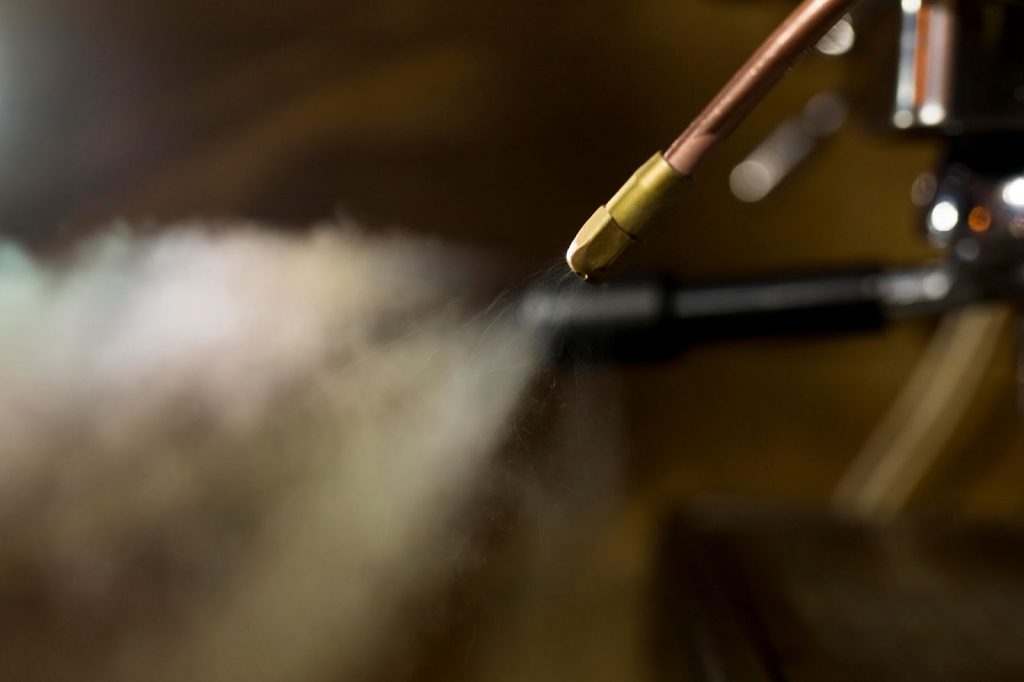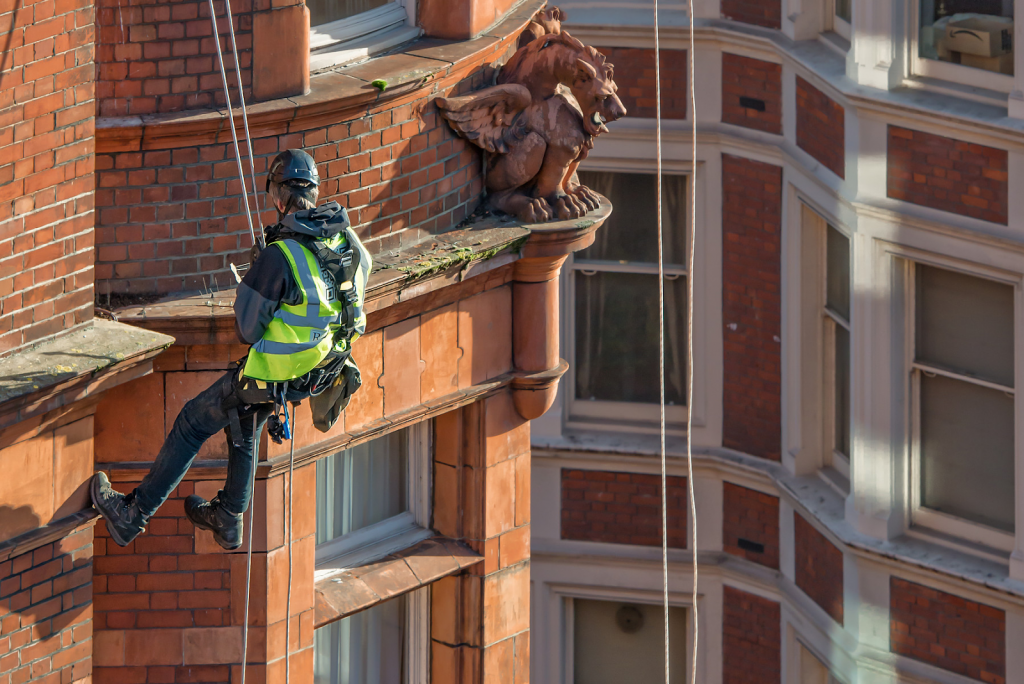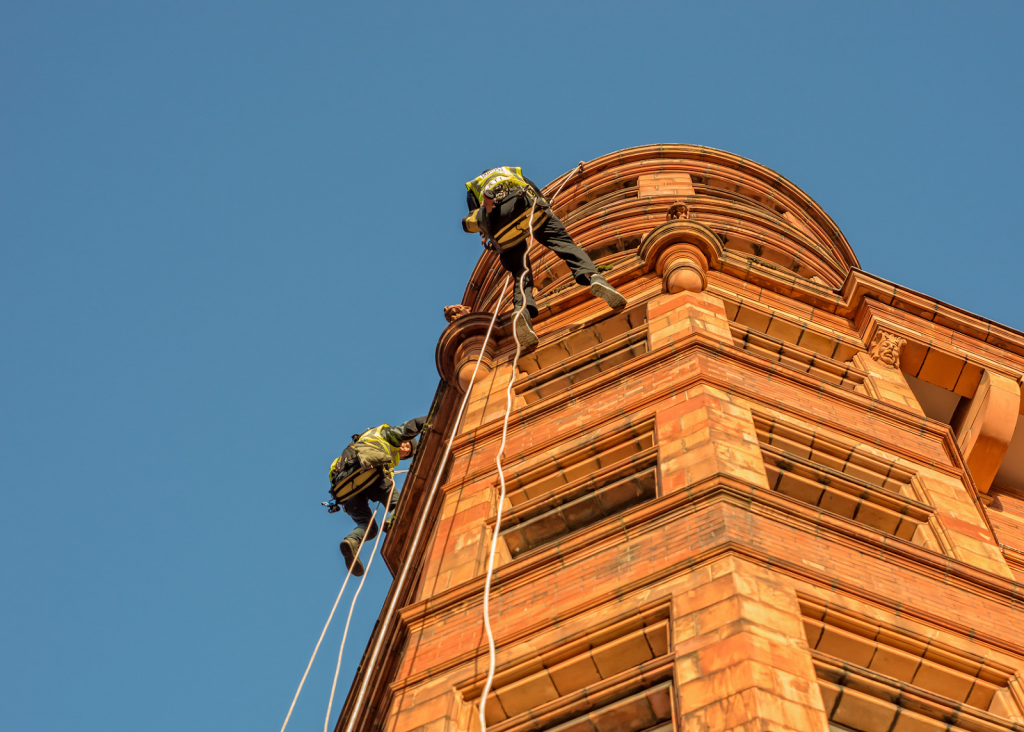
When you’re managing industrial facilities with towering silos that reach dizzying heights, traditional scaffolding solutions quickly become impractical nightmares.
At Rope Access in London (RAIL), our rope access techniques allow us to access even the most challenging silo structures with minimal disruption, maximum safety, and a fraction of the cost you’d expect from conventional methods. Our specialist technicians can reach any point on your silo infrastructure.
Why Is Rope Access the Optimal Solution for Silo Maintenance?
Traditional access methods for silo repair involve either hiring massive mobile cranes or erecting scaffolding. Both options share common drawbacks: they’re expensive, time-consuming, and disruptive to your operations.
Rope access techniques eliminate these headaches entirely. Our technicians descend from the top of your silo or access structures from multiple angles using precisely engineered rope systems.
The efficiency gains are remarkable. Where scaffold erection might take two weeks before work even begins, our teams can be on-site and operational the same day.
Beyond economics, there’s the safety consideration. Contrary to what you might think, rope access is statistically safer than traditional methods. Our technicians are qualified to international standards (IRATA or similar), with rigorous training in fall protection, rescue procedures, and technical rope work.
We’ve worked on silos across diverse industries, from agricultural storage facilities to chemical processing plants. Our industrial maintenance expertise extends beyond silos too; we regularly service wind turbines and oil and gas rigs, where rope access is often the only practical solution.
What Types of Silo Repairs Can Rope Access Technicians Perform?
The versatility of rope access might surprise you. When people hear “rope access,” they often imagine basic inspections or cleaning work. In reality, our technicians are highly skilled tradespeople who happen to work at height — we employ specialist welders, electricians, painters, and more.
Structural Plate Repairs and Welding
Silo plate repair is perhaps our most common request, and understandably so. Steel plates deteriorate through corrosion, mechanical damage, or simple fatigue. These repairs require precision welding at height — a job that demands both technical welding expertise and rope access proficiency.
Our rope access welders are dual-qualified professionals who can perform hot work whilst suspended on ropes. We conduct full plate replacements, crack repairs, and reinforcement welding. All welding work adheres to the relevant British and European standards.
Traditional methods often require draining the silo and extensive access equipment. We can frequently conduct external repairs whilst the silo remains operational, minimising downtime and production losses.
Protective Coating Applications and External Painting
Silos face brutal environmental conditions. Whether it’s coastal salt spray, industrial pollutants, or temperature cycling, unprotected steel doesn’t stand a chance.
Our external painting and coating services employ industrial-grade protective systems tailored to your environment. It’s a systematic approach involving surface preparation, primer application, intermediate coats, and topcoat systems.
The rope access advantage here is substantial. Painting a 40-metre silo with scaffolding might take weeks; our teams can complete the same job in days.
Waterproofing and Sealing Solutions
Water is the silent destroyer of silo infrastructure. It infiltrates through failed joints, damaged seals, and corroded plates, causing havoc with both the structure and stored contents. Our waterproofing services address these vulnerabilities before they escalate into major problems.
The inspection component is equally important. Using rope access, we can thoroughly examine every inch of your silo’s envelope, identifying potential failure points before they become actual failures.
How Do We Ensure Safety and Quality Standards in High-Altitude Silo Work?
Working at height on critical infrastructure isn’t for the faint-hearted, and it certainly isn’t something you approach casually. At RAIL, safety is embedded in everything we do.
Rigorous Planning and Risk Assessment
Every silo project begins with comprehensive planning. We conduct site surveys, often using our building surveying expertise to assess the structure’s condition and identify access challenges.
Our planning considers your operational requirements. Can the silo remain in service during work? Do we need hot work permits? Are there environmental concerns about debris or coating materials?
By addressing these questions upfront, we eliminate surprises and ensure smooth project execution.
Qualified Technicians and Continuous Training
Rope access technicians undergo more stringent qualification processes than many other trades. IRATA (Industrial Rope Access Trade Association) certification requires not just initial training but ongoing assessment and revalidation.
Our technicians hold multiple qualifications — rope access credentials combined with trade skills (welding, painting, electrical work, etc.).
Equipment Standards and Inspection Protocols
Every piece of equipment we use undergoes rigorous inspection before, during, and after use. Ropes, harnesses, anchors, and descent devices are checked according to manufacturer specifications and industry standards.
Versatility Across Sectors
Our experience extends far beyond silos. We’ve applied these same rigorous standards to wind turbine maintenance at heights exceeding 100 metres, oil and gas rig installations in challenging offshore environments, and complex commercial building maintenance projects.
This diverse experience means we bring proven solutions to your silo challenges, regardless of how unusual they might seem.
The Future of Silo Maintenance Is Already Here
The industrial landscape is changing. Facilities are running leaner, maintenance budgets are scrutinised more intensely, and downtime is increasingly unacceptable.
Traditional access methods — with their high costs, long timelines, and operational disruptions — simply don’t align with modern industrial realities.
If your silos are showing signs of wear, if you’re planning maintenance activities, or if you simply want to understand what’s possible with modern rope access techniques, we’re here to help.


















